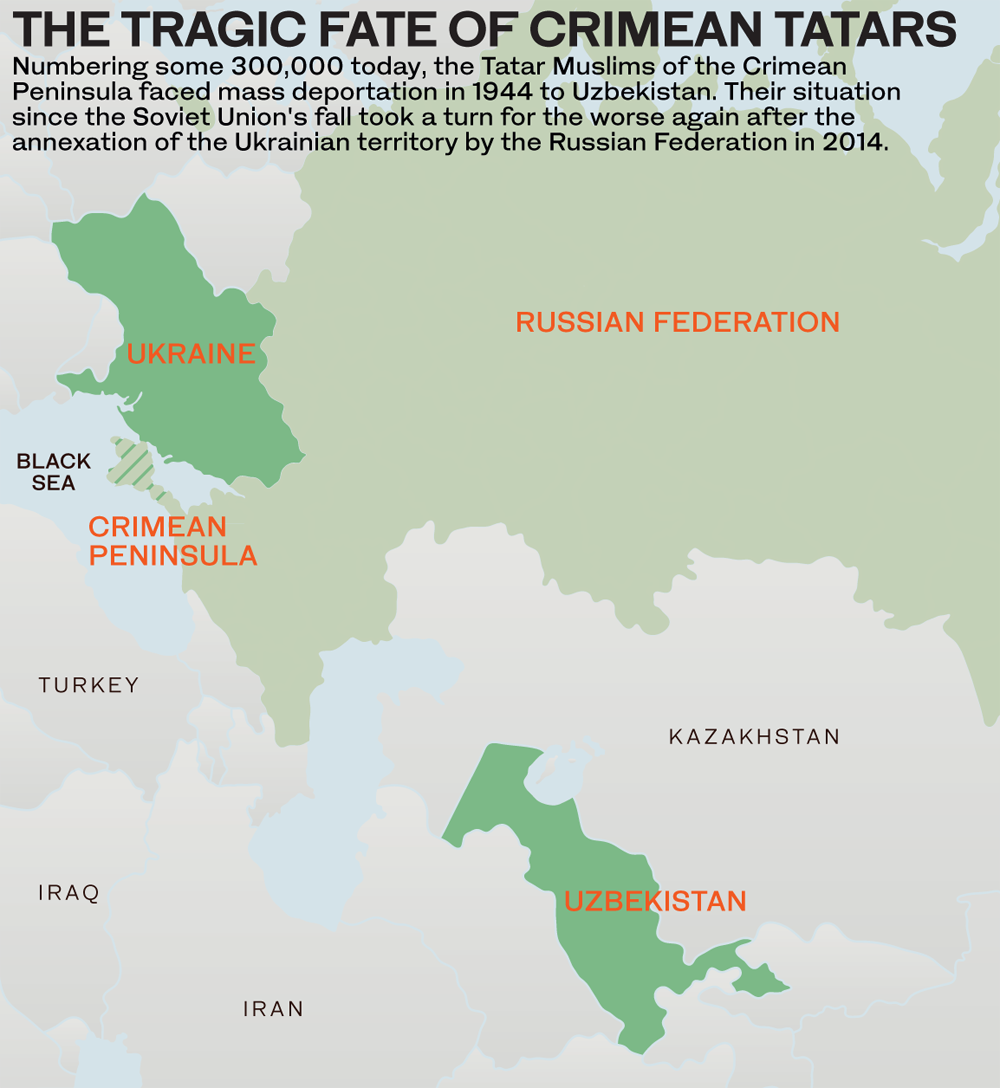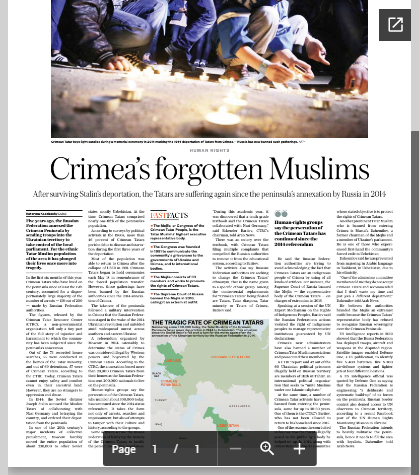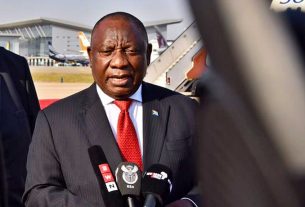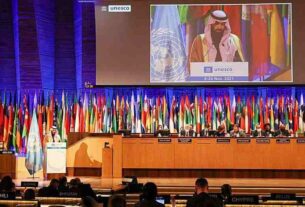Crimean Tatars stage a protest against Russian President Vladimir Putin’s visit to Istanbul on Monday, DEC 2, 2014. | AP
Sun 11 August 2019:
Five years ago, the Russian Federation annexed the Crimean Peninsula after unmarked troops marched into the Ukrainian territory and took control of the local parliament.
In the first six months of this year, Crimean Tatars who have lived on the peninsula since at least the 15th century, accounted for a disproportionately large majority of the number of arrests — 138 out of 200 — made by Russian Federation authorities.
The figures, released by the Crimean Tatar Resource Center (CTRC), a non-governmental organization, tell only a tiny part of the full story of injustice and harassment to which the community has been subjected since the peninsula’s annexation.
Out of the 73 recorded house searches, 55 were conducted in the homes of the Tatar minority, and out of 69 detentions, 57 were of Crimean Tatars, according to the CTRC. Today, Crimean Tatars cannot enjoy safety and comfort even in their ancestral land. However, they are no strangers to oppression and abuse.
FAST FACTS
- The Mejlis, or Congress of the Crimean Tatar People, is the Tatar Muslims’ highest executive representative body.
- The Congress was founded in 1991 to communicate the community’s grievances to the governments of Ukraine and Crimea, and to international bodies.
- The Mejlis consists of 33 members and works to promote the rights of Crimean Tatars.
- The Supreme Court of Russia banned the Mejlis in 2016, calling it an extremist outfit.
In 1944, the Soviet dictator Joseph Stalin accused the Muslim Tatars of collaborating with Nazi Germany and betraying the country, and ordered their deportation from the peninsula.
In one of the 20th century’s major incidents of collective punishment, Moscow forcibly moved the entire population of about 230,000 to other Soviet states, mostly Uzbekistan. At the time, Crimean Tatars comprised nearly one-fifth of the peninsula’s population.
Russian police detain Crimean Tatar protesters on Moscow’s Red Square
According to surveys by political activists in the 1960s, more than 46 percent of Crimean Tatars perished due to disease and starvation during the first three years of the deportation.
Most of the population was able to return to Crimea after the collapse of USSR in 1991. Crimean Tatars began to hold ceremonies each May 18 in remembrance of the forced population transfer. However, those gatherings have been banned by the Russian authorities since the 2014 annexation of Crimea.
The takeover of the peninsula followed a military intervention in Crimea that the Russian Federation staged in the wake of the 2014 Ukrainian revolution and unfolded amid widespread unrest across southern and eastern Ukraine.
A referendum organized by Moscow in 2014 ostensibly to determine the status of Crimea was considered illegal by Western powers and boycotted by the Crimean Tatars. According to the CTRC, the annexation forced more than 20,000 Crimean Tatars from their homes as the Russian Federation sent 200,000 nationals to live on the peninsula.

Human-rights groups say the persecution of the Crimean Tatars, who number about 300,000 today, has continued since the 2014 status referendum. It takes the form not only of arrests, searches and imprisonment, but also of attempts to tamper with their culture and history, according to the groups.
Some activists accuse the Russia Federation of falsifying the history of the Crimean Tatars to justify the persecution of the population. “During this academic year, it was discovered that a tenth grade textbook said the Crimean Tatars collaborated with Nazi Germany,” said Eskender Bariiev, CTRC’s chairman, told Arab News.
There was an outcry over the textbook, with Crimean Tatars filing multiple complaints that compelled the Russian authorities to remove it from the educational system, according to Bariiev.
The activists also say Russian Federation authorities are seeking to change the Crimean Tatars’ ethnonym, that is the name given to a specific ethnic group. Among the controversial replacements for “Crimean Tatars” being floated are Tatars, Tatar diaspora, Tatar minority or Tatars of Crimea, Bariiev said.
He said the Russian Federation authorities are trying to avoid acknowledging the fact that Crimean Tatars are an indigenous people of Crimea by using of all kinds of artifices. For instance, the Supreme Court of Russia banned the Mejlis — the representative body of the Crimean Tatars — on charges of extremism in 2016.
Speaking at a session of the UN Expert Mechanism on the Rights of Indigenous Peoples, Bariiev said the Russian Federation’s actions violated the right of indigenous peoples to manage representative institutions guaranteed by UN declarations.
Aside from the Mejlis, Crimea’s new administrators have banned a number of Crimean Tatar Muslim associations and groups and prosecuted their members.
A CTRC report said 42 out of the 60 Ukrainian political prisoners illegally held on Russian territory are members of Hizb ut-Tahrir, an international political organization that seeks to “unite Muslims under one Islamic caliphate.”
At the same time, a number of Crimean Tatar activists have been banned from entering the peninsula, some for up to 30-50 years. One of them is the CTRC’s Bariiev, who has not been allowed to return to his homeland since 2015.
One of the reasons the court cited in his case was the threat allegedly posed to the public by a body he helped set up. In 2014, along with others Bariiev formed a committee whose stated objective is to protect the rights of Crimean Tatars.
“Human-rights groups say the persecution of the Crimean Tatars has continued since the 2014 referendum”
Another prominent Tatar Muslim who is banned from entering Crimea is Mustafa Dzhemilov, a former chairman of the Mejlis and a member of Ukraine’s parliament. He is one of those who experienced first-hand the community’s forced exile in Uzbekistan.
Dzhemilov said he was prevented from majoring in Arabic language in Tashkent, in Uzbekistan, due to his ethnicity.
“One of the admissions committee members told me they do not accept Crimean Tatars and recommended that I don’t waste my time and just join a different department,” Dzhemilov told Arab News.
He believes the authorities branded the Mejlis an extremist outfit because the Crimean Tatars’ representative body has refused to recognize Russian sovereignty over the Crimean Peninsula.
US intelligence reports in 2019 showed that the Russia Federation has deployed troops, aircraft and weapons in the disputed region. Satellite images enabled Defense One, a US publication, to identify five S-400 batteries, five S-300 air-defense systems and fighter jets at four different locations.
A US intelligence official was quoted by Defense One as saying that the Russian Federation is engineering “a deliberate and systematic build-up” of its forces on the peninsula. Russian border control also denied access to UN observers to Crimean territory, according to a recent Facebook post of the UN Human Rights Monitoring Mission in Ukraine.
The Russian Federation intends to heavily militarize the peninsula, hence it needs to fill the area with loyalists, Dzhemilov told Arab News.
-Source: Arab News
Think your friends would be interested? Share this story!






